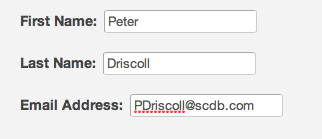
You can start a local SMTP debugging server by typing the following in Command Prompt: Running a local debugging server means it’s not necessary to deal with encryption of messages or use credentials to log in to an email server. Rather than sending emails to the specified address, it discards them and prints their content to the console. You can test email functionality by running a local SMTP debugging server, using the smtpd module that comes pre-installed with Python.
AUTOMATIC EMAIL SENDER THANK YOU HOW TO
If you don’t want to lower the security settings of your Gmail account, check out Google’s documentation on how to gain access credentials for your Python script, using the OAuth2 authorization framework. Be aware that this makes it easier for others to gain access to your account. To set up a Gmail address for testing your code, do the following: For example, mail sent to and will both arrive at When testing email functionality, you can use this to emulate multiple addresses that all point to the same inbox.


Also, I found that the inbox of my testing account rapidly filled up with test emails, which is reason enough to set up a new Gmail account for development.Ī nice feature of Gmail is that you can use the + sign to add any modifiers to your email address, right before the sign. This is because you’ll have to adjust your Gmail account’s security settings to allow access from your Python code, and because there’s a chance you might accidentally expose your login details. If you decide to use a Gmail account to send your emails, I highly recommend setting up a throwaway account for the development of your code. Remove ads Option 1: Setting up a Gmail Account for Development A local SMTP debugging server can be useful for fixing any issues with email functionality and ensuring your email functions are bug-free before sending out any emails. To get started with this tutorial, set up a Gmail account for development, or set up an SMTP debugging server that discards emails you send and prints them to the command prompt instead. Although the majority of email providers use the same connection ports as the ones in this tutorial, you can run a quick Google search to confirm yours. The examples in this tutorial will use the Gmail SMTP server to send emails, but the same principles apply to other email services. smtplib uses the RFC 821 protocol for SMTP. Python comes with the built-in smtplib module for sending emails using the Simple Mail Transfer Protocol (SMTP). You’ll find a few transactional email services at the end of this tutorial, which will come in useful when you want to send a large number of emails.įree Download: Get a sample chapter from Python Tricks: The Book that shows you Python’s best practices with simple examples you can apply instantly to write more beautiful + Pythonic code.
AUTOMATIC EMAIL SENDER THANK YOU CODE
Use the Yagmail package to send email through your Gmail account using only a few lines of code Send multiple personalized emails using a CSV file with contact data Send emails with HTML content and attachments using the email package Use Python’s built-in smtplib library to send basic emails

Set up a secure connection using SMTP_SSL() and. Sending emails manually is a time-consuming and error-prone task, but it’s easy to automate with Python. Perhaps you want to receive email reminders from your code, send a confirmation email to users when they create an account, or send emails to members of your organization to remind them to pay their dues. You probably found this tutorial because you want to send emails using Python. Watch it together with the written tutorial to deepen your understanding: Sending Emails With Python Watch Now This tutorial has a related video course created by the Real Python team.


 0 kommentar(er)
0 kommentar(er)
